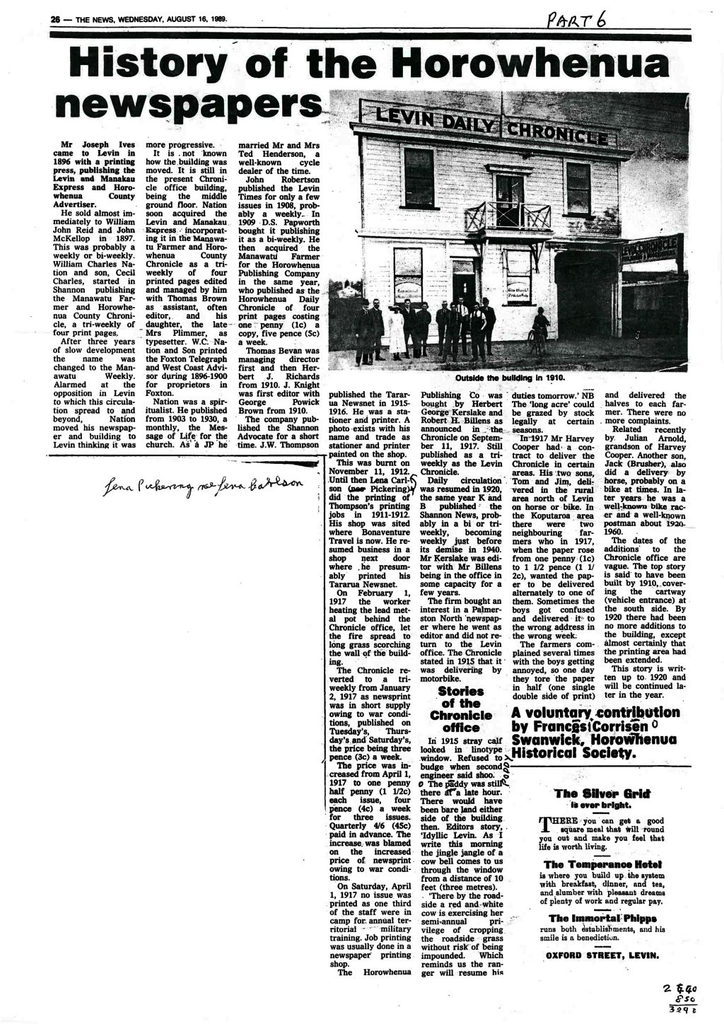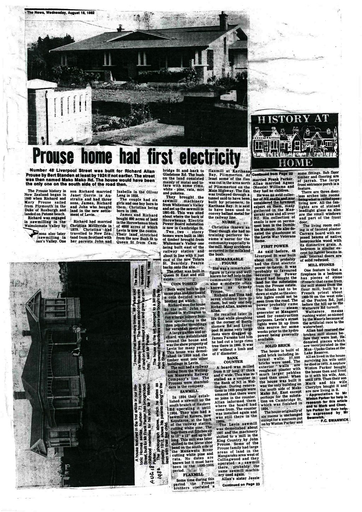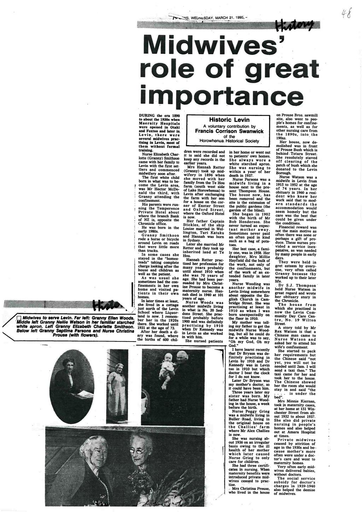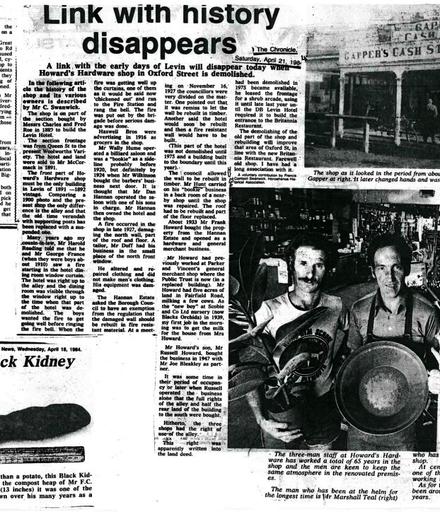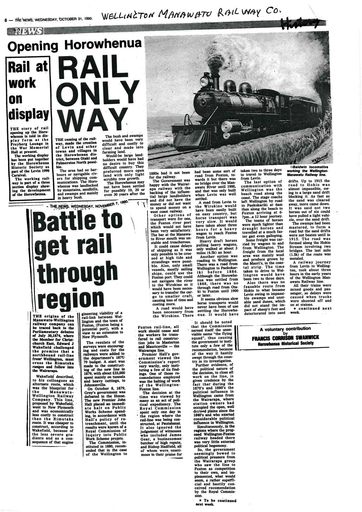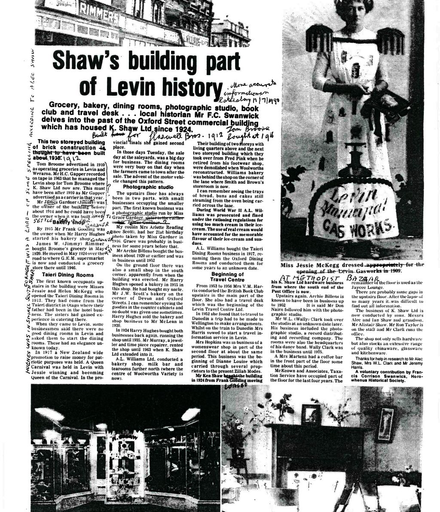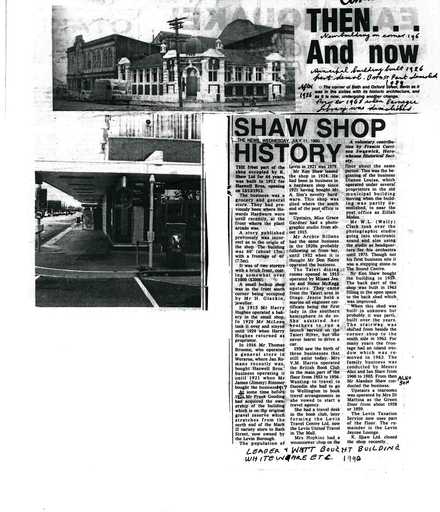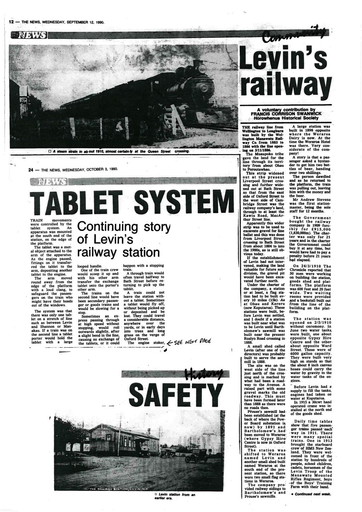Mr Joseph Ives came to Levin in 1896 with a printing press, publishing the Levin and Manakau Express and Horowhenua County Advertiser. He sold almost immediately to William John Reid and John McKellop in 1897.
This was probably a weekly or bi-weekly. William Charles Nation and son, Cecil Charles, started in Shannon publishing the Manawatu Farmer and Horowhenua County Chronicle, a tri-weekly of four print pages.
After three years of slow development the name was changed to the Manawatu Weekly. Alarmed at the opposition in Levin to which this circulation spread to and beyond, Nation moved his newspaper and building to Levin thinking it was more progressive.
It is not known how the building was moved. It is still in the present Chronicle office building, being the middle ground floor. Nation soon acquired the Levin and Manakau Express incorporating it in the Manawatu Farmer and Horowhenua County Chronicle as a tri-weekly of four printed pages edited and managed by him with Thomas Brown as assistant, often editor, and his daughter, the later Mrs Plimmer, as typesetter. W.C. Nation and Son printed the Foxton Telegraph and West Coast Advisor during 1896-1900 for proprietors in Foxton.
 Nation was a spiritualist. He published from 1903 to 1930, a monthly, the Message of Life, for the church. As a JP he married Mr and Mrs Ted Henderson, a well-known cycle dealer of the time.
Nation was a spiritualist. He published from 1903 to 1930, a monthly, the Message of Life, for the church. As a JP he married Mr and Mrs Ted Henderson, a well-known cycle dealer of the time.
John Robertson published the Levin Times for only a few issues in 1908, probably a weekly. In 1909 D.S. Papworth bought it, publishing it as a bi-weekly. He then acquired the Manawatu Farmer from the Horowhenua Publishing Company in the same year, who published as the Horowhenua Daily Chronicle of four print pages costing one penny (1c) a copy, five pence (5c) a week.
Thomas Bevan was managing director first and then Herbert J. Richards from 1910. J. Knight was first editor with George Powick Brown from 1910.
The company published the Shannon Advocate for a short time. J.W. Thompson published the Tararua Newsnet in 1915-1916. He was a stationer and printer. A photo exists with his name and trade as stationer and printer painted on the shop.
This was burnt on November 11, 1912. Until then Lena Pickering nee Lena Carlson did the printing of Thompson’s printing jobs in 1911-1912. His shop was sited where Bonaventure Travel is now. He resumed business in a shop next door where he presumably printed his Tararua Newsnet.
On February 1, 1917 the worker heating the lead metal pot behind the Chronicle office, let the fire spread to long grass scorching the wall of the building.
The Chronicle reverted to a tri-weekly from January 2, 1917 as newsprint was in short supply owing to war conditions, published on Tuesday’s, Thursday’s and Saturday’s, the price being three pence (3c) a week. The price was increased from April 1, 1917 to one penny (11/2c) each issue, four pence (4c) a week for three issues. Quarterly 4/6 (45c) paid in advance. The increase was blamed on the increased price of newsprint owing to war conditions.
On Saturday, April 1, 1917 no issue was printed as one third of the staff were in camp for annual territorial military training. Job printing was usually done in a newspaper printing shop.
The Horowhenua Publishing Co was bought by Herbert George Kerslake and Robert H. Billens as announced in the Chronicle on September 11, 1917. Still published as a tri-weekly as the Levin Chronicle.
Daily circulation was resumed in 1920, the same year K and B published the Shannon News, probably in a bi or tri-weekly, becoming weekly just before its demise in 1940. Mr Kerslake was editor with Mr Billens being in the office in some capacity for a few years.
The firm bought an interest in a Palmerston North newspaper where he went as editor and did not return to the Levin office. The Chronicle stated in 1915 that it was delivering by motorbike.
Stories of the Chronicle Office
In 1915 a stray calf looked in the linotype window. Refused to budge when second engineer said shoo.
The paddy was still there at a late hour. There would have been bare land either side of the building then. Editors story, ‘Idyllic Levin. As I write this morning the jingle jangle of a cow bell comes to us through the window from a distance of 10 feet (three metres).
‘There by the roadside a red and white cow is exercising her semi-annual privilege of cropping the roadside grass without risk of being impounded. Which reminds us the ranger will resume his duties tomorrow.’ NB The ‘long acre’ could be grazed by stock legally at certain seasons.
In 1917 Mr Harvey Cooper had a contract to deliver the Chronicle in certain areas. His two sons, Tom and Jim, delivered in the rural area north of Levin on horse or bike. In the Koputaroa area there were two neighbouring farmers who in 1917, when the paper rose from one penny (1c) to 1 ½ pence (1 1/2c), wanted the paper to be delivered alternately to one of them. Sometimes the boys got confused and delivered it to the wrong address in the wrong week.
The farmers complained several times with the boys getting annoyed, so one day they tore the paper in half (one single double side of print) and delivered the halves to each farmer. There were no more complaints.
Related recently by Julian Arnold, grandson of Harvey Cooper. Another son, Jack (Brusher), also did a delivery by horse, probably on a bike at times. In latter years he was a well-known bike racer and a well known postman about 1920-1960.
The dates of the additions to the Chronicle office are vague. The top story is said to have been built by 1910, covering the cartway (vehicle entrance) at the south side. By 1920 there had been no more additions to the building, except almost certainly that the printing area had been extended.
This story is written up to 1920 and will be continued later in the year.
The News, 16 August 1989


